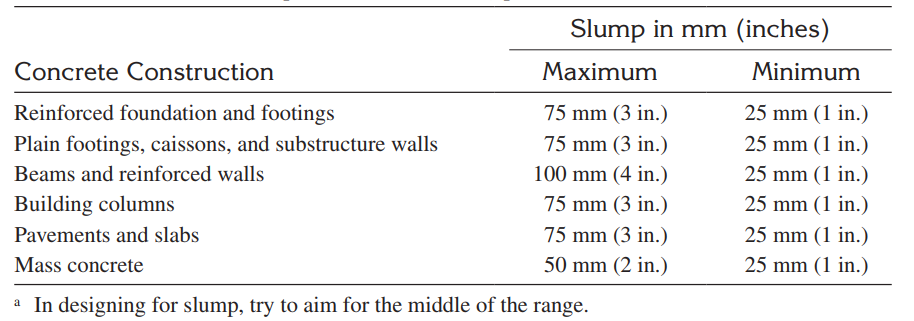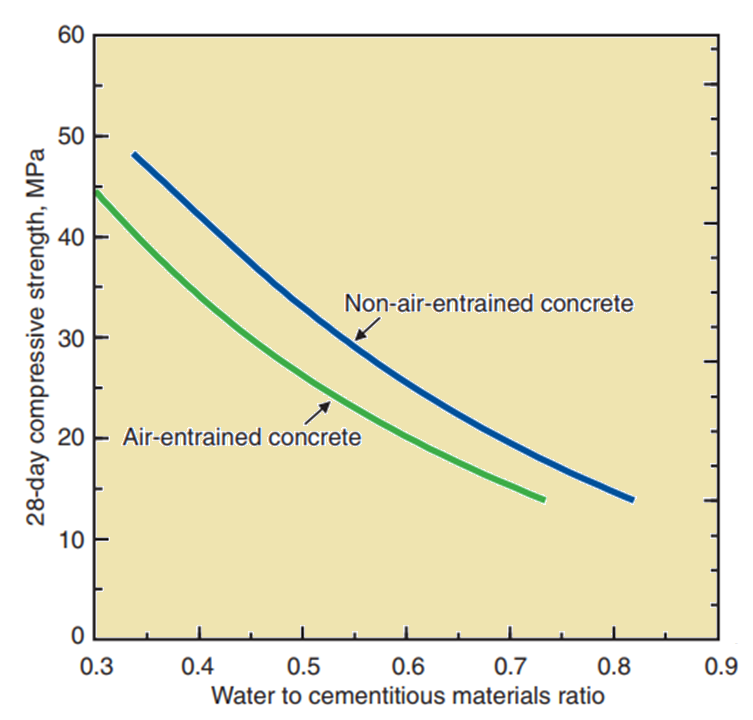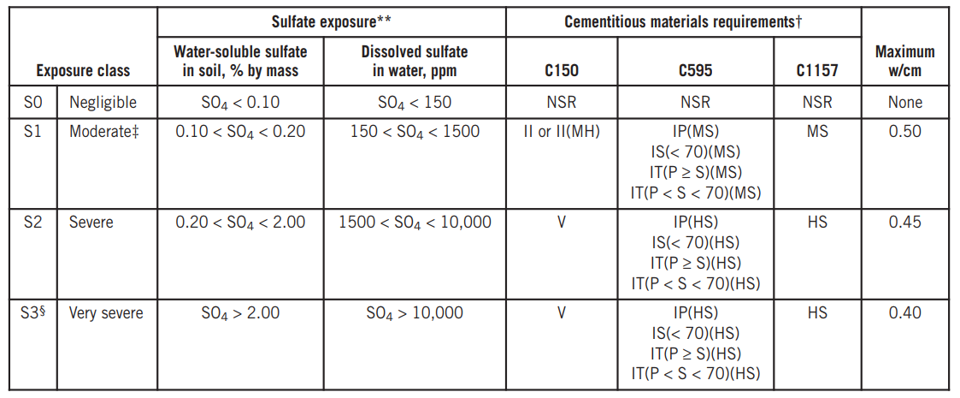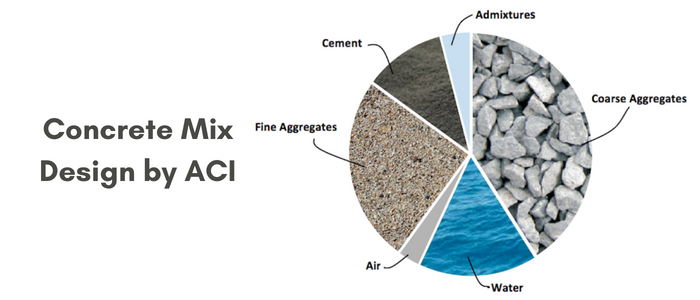This article describes in detail the procedure to Concrete Mix Design by ACI followed by an example. Let us start with the basics of mix design.
What is Concrete Mix Design?
Simply put, the concrete mix design means to find the types of materials to be used in the concrete mix in addition to their quantities.
If you have previous data on a certain mixture design, you can use these data to find mix design that suits your situation. When there are no existing records or they are insufficient, the concrete mixture must be determined by trial mixtures.
Basis of ACI Concrete Mix Design
The ACI method of concrete mix design depends on the absolute volume procedure, where the volume of each component is calculated and the formula that governs the volume is that:
the summation of volumes of all components (such as cement, water, aggregate, etc) in the concrete mix is 1.
The method is suitable for normal and heavyweight concretes having a maximum 28-day cylinder compressive strength of 45 MPa
Required Data for Mix Design
Certain design objectives must be established beforehand. These are as follows:
- Required 28-day compressive strength, f′c
- Portland cement content based upon a water-to-cement (w/c) ratio
- Under certain conditions, the minimum specified cement content.
- Maximum allowable w/c ratio.
- Maximum size of the large aggregates.
- Acceptable range of slumps and the percent of air for an air-entrained concrete.
Also, some physical properties of used materials need to be determined in lab before proceeding with the design process, which are:
- Apparent specific gravity of the Portland cement.
- Bulk specific gravities and percent of moisture present in the saturated surface dry (SSD) condition for both the coarse and fine aggregates.
- Rodded unit weight of the coarse aggregates. Fineness modulus (FM) of the fine aggregates.
- Free moisture present in both the coarse and the fine aggregates.
Step for Concrete Mix Design by ACI Method
First keep in mind that we are using the absolute volume method for mix design and the size of the design batch will be one cubic meter
The unit weight and the yield are two additional factors that must be taken into account while trial mix proportioning. The yield is computed by dividing the total weight of all the components batched by the unit weight of the freshly mixed concrete. The unit weight of freshly mixed concrete is stated as a weight per volume.
The word “batch” means the amount of materials needed for a particular procedure.
Concrete needs to be completely mixed to get an uniform appearance.
Step 1: Determine the Target Strength for Mix Design
In mix design, we do not design directly on the characteristic compressive strength. We increase it a little bit as a factor of safety to account for the variability sources on site. Thus, we design on a value called target mean strength.
Target mean strength (fm) is defined as the design strength determined for the manufacture of reinforced concrete. Target mean strength is determined by the formula:
Step 1: Select Workability Level
Depending on the type of construction, you choose the desired value of slump. According to ACI 211 Report for the proportioning of concrete mixtures, the following value can be used as a guide for slump values.

Step 2: What is the Maximum Aggregate Size
In this step, you determine the maximum size of coarse aggregate to be used in concrete. Depending on the type of construction and the local available materials, the max. size of aggregate is selected.
Generally, the nominal max. aggregate size should not exceed the following three rules:
- 1/5 the narrowest distance between sides of forms
- 3/4 the clear spacing between reinforcing bars or between a bar and the side of the form.
- 1/3 depth of slab
Step 3: Determine the Water-to-cement Ratio (W/C)
Here, we find the water-to-cement ratio that achieves both the strength and durability requirements.
First, we select the w/c that achieves the strength requirements.

From the above curve, you can choose the w/c that achieve the strength requirements. This value depends on whether the concrete is air-entrained or not.
Depending on the exposure conditions, you choose an air-entrained concrete if it is serving in freezing-thawing environments.
So, we determined target mean strength in Step 1 and we use it here to get w/c.
Draw a horizontal line at the value of the strength until it hits the curve of either the air-entrained or non-air entrained concrete; From that point, draw a vertical line that hits the w/c axis and get the value of the w/c.
Then, we determine the value of w/c that achieves the durability conditions according to ACI from the below tables depending on the exposure conditions.


The Final w/c will be the min of:
- w/c for strength
- w/c for durability
Step 4: Determine the Amount of Mixing Water and Air
In this step, we determine the amount of water for use in the mix to achieve the target slump.
The amount of water depends on the type of concrete: air entrained or non-air entrained, max. aggregate size, and the slump level.
We can get the amount of water and air content from the following tables.
Non-air entrained concrete
| Slump | Amount of mixing water, Kg/m3
depending on the max. size of coarse aggregate (mm) |
|||||||
| 9.5 | 12.5 | 19 | 25 | 37.5 | 50 | 75 | 150 | |
| 25-50 mm | 207 | 199 | 190 | 179 | 166 | 154 | 130 | 113 |
| 75-100 mm | 228 | 216 | 205 | 193 | 181 | 169 | 145 | 124 |
| 150-175 mm | 243 | 228 | 216 | 202 | 190 | 178 | 160 | —- |
| Typical entrapped air (%) | 3 | 2.5 | 2 | 1.5 | 1 | 0.5 | 0.3 | 0.2 |
Air entrained concrete
| Slump | Amount of mixing water, Kg/m3
depending on the max. size of coarse aggregate (mm) |
|||||||
| 9.5 | 12.5 | 19 | 25 | 37.5 | 50 | 7 | 150 | |
| 25-50 | 181 | 175 | 168 | 160 | 150 | 142 | 122 | 107 |
| 75-100 | 202 | 193 | 184 | 175 | 165 | 157 | 133 | 119 |
| 150-175 | 216 | 205 | 197 | 184 | 174 | 166 | 154 | —- |
| Recommended air content (%) for different level of freezing-thawing exposure | ||||||||
| Mild exposure | 4.5 | 4 | 3.5 | 3 | 2.5 | 2 | 1.5 | 1 |
| Moderate exposure | 6 | 5.5 | 5 | 4.5 | 4.5 | 4 | 3.5 | 3 |
| Severe exposure | 7.5 | 7 | 6 | 6 | 5.5 | 5 | 4.5 | 4 |
Step 5: Determine the Cement Content
Now, we have the amount of water from the previous step and we also have the water/cement ratio from Step 3.
Thus, we can determine the amount of cement.
Cement Content = water content / w/c ratio
Compare the obtained cement content with the minimum amount permissible by code or specs.
For example, ACI 302 report “Guide for Concrete Floor and Slab Construction” the minimum cement content is as in the following table.
Minimum Portland Cement Requirements for Normal-Density Concrete Placed in Slabs and Pavements
| Max. Aggregate Size | Portland cement Kg/m3 |
| 40 | 282 |
| 20 | 324 |
| 14 | 354 |
| 10 | 366 |
Step 6: Determination of Coarse Aggregate Content
Here, depending on the fineness modulus of sand and max. aggregate size of coarse aggregate, we determine the volume of the coarse aggregate in the concrete mix.
Volume of Rodded Coarse Aggregates per Unit Volume of Concrete for Different Fineness Moduli of Fine Aggregates
| Max. aggregate size (mm) | Fineness modulus of fine aggregate | |||
| 2.40 | 2.60 | 2.80 | 3 | |
| 9.5 | 0.50 | 0.48 | 0.46 | 0.44 |
| 12.5 | 0.59 | 0.57 | 0.55 | 0.53 |
| 19 | 0.66 | 0.64 | 0.62 | 0.60 |
| 25 | 0.71 | 0.69 | 0.67 | 0.65 |
| 37.5 | 0.75 | 0.73 | 0.71 | 0.69 |
| 50 | 0.78 | 0.76 | 0.74 | 0.72 |
| 76 | 0.82 | 0.80 | 0.78 | 0.76 |
Step 7: Determination of Fine Aggregate Content
Here we have the contents of all components in the concrete mixture except the fine aggregate (sand). As we mentioned earlier, the ACI uses the absolute volume method.
We have masses at the moments not volumes. So we need to convert the masses first to volumes.
Absolute volume = mass of material / [relative density of a material * density of water]
Note: relative density is the specific gravity of material.
once you have the volume of everything, you can subtract these volumes from one
and the result is the volume of fine aggregate.
Mass of sand = volume * specific gravity of sand * density of water.
Now, you got everything.
Step 8: Adjustments to consider the moisture of aggregate and trial batching
We now need to consider the existing moisture content in the aggregate because it is not obtained from the quarry in completely dry state.
so we adjust the moisture content of the aggregate and accordingly we adjust the water amount.
Then, with the final amounts, you do a trial batch to make sure you have all the properties you need. If something needs to adjusted, you do it according to the trial batch.
Click here for the example on mix design by ACI
Read Also:
